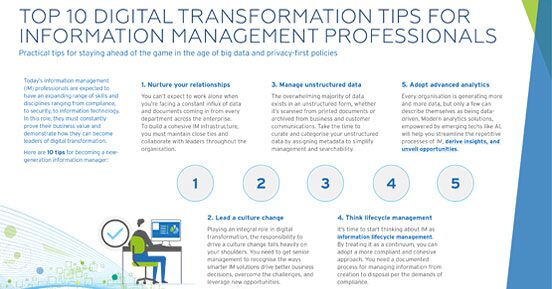Elevate the power of your work
Pyydä ilmainen konsultaatio jo tänään
Practical tips for staying ahead of the game in the age of big data and privacy-first policies

Today’s information management (IM) professionals are expected to have an expanding range of skills and disciplines ranging from compliance, to security, to information technology. In this role, they must constantly prove their business value and demonstrate how they can become leaders of digital transformation.
Here are 10 tips for becoming a newgeneration information manager:
You can’t expect to work alone when you’re facing a constant influx of data and documents coming in from every department across the enterprise. To build a cohesive IM infrastructure, you must maintain close ties and collaborate with leaders throughout the organisation.
Playing an integral role in digital transformation, the responsibility to drive a culture change falls heavily on your shoulders. You need to get senior management to recognise the ways smarter IM solutions drive better business decisions, overcome the challenges, and leverage new opportunities.
The overwhelming majority of data exists in an unstructured form, whether it’s scanned from printed documents or archived from business and customer communications. Take the time to curate and categorise your unstructured data by assigning metadata to simplify management and searchability.
It’s time to start thinking about IM as information lifecycle management. By treating it as a continuum, you can adopt a more compliant and cohesive approach. You need a documented process for managing information from creation to disposal per the demands of compliance.
Every organisation is generating more and more data, but only a few can describe themselves as being datadriven. Modern analytics solutions, empowered by emerging techs like AI, will help you streamline the repetitive processes of IM, derive insights, andunveil opportunities.
The typical IM environment comprises a dizzying array of different systems and formats, which together combine to make the potential attack surface larger than ever.To take back control over security, you need to know where your data lives and how it’s protected.
All too often fragmented information ecosystems lead to multiple data entries and all the inconsistencies and information silos that come with it. Developing a cohesive environment with a single repository for information should be a top priority.
Information needs to be secure yet readily accessible at the same time. Any information which is still potentially useful should be instantly available, preferably through the cloud to eliminate the need for manual exchange. Any information which is outdated or irrelevant should be securely retired.
With most businesses still exchanging documents and records via email, it’s hardly surprising so many go missing. To reduce the risk of information being sent out over insecure channels or to the wrong person, you need a secure collaboration platform where all authorised parties can readily access the records they need.
Traditionally, information privacy was an afterthought until it became apparent that companies were collecting and using huge amounts of customer information without their knowledge or permission. With the enactment of GDPR, you must implement privacy by design and by default as part of your information lifecycle management strategy.
Pyydä ilmainen konsultaatio jo tänään

